Surf MoviesHeavy Water and Helicopters: Nathan Fletcher’s Acid Drop
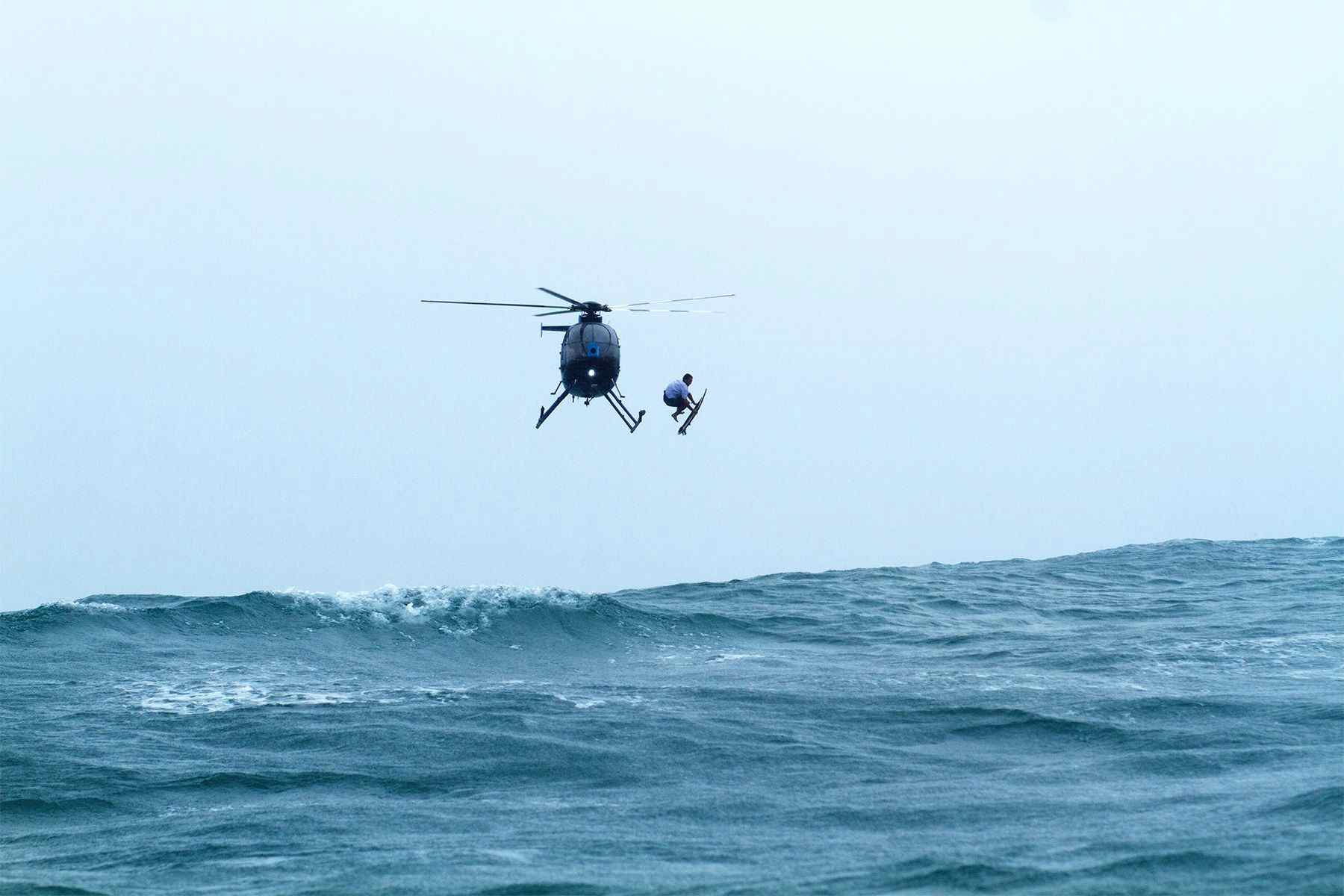
Nathan Fletcher is a surfer who is very familiar with heavy water, and heavy situations. He’s pursued heavy water in his surfing life, and heavy situations have followed him in his personal life, most notably the deaths of friends Andy Irons, Sion Milosky and Kirk Passmore, and his close friendship with the late Jay Adams. Heavy Water is a film that charts Nathan’s family history, life and achievements in surfing in parallel with the human stories that surrounded them; it’s a tense, often dark, ride as you might expect from director Michael Oblowitz (the unavailable Sea of Darkness). The film culminates in Nathan fulfilling a long-standing dream to jump out of a helicopter with a surfboard into a large wave.
Ahead of Heavy Water’s premiere, Surf Simply sat down with the star and the director to dig into how Heavy Water came to pass, and to find out more about how they pulled off the helicopter acid drop.
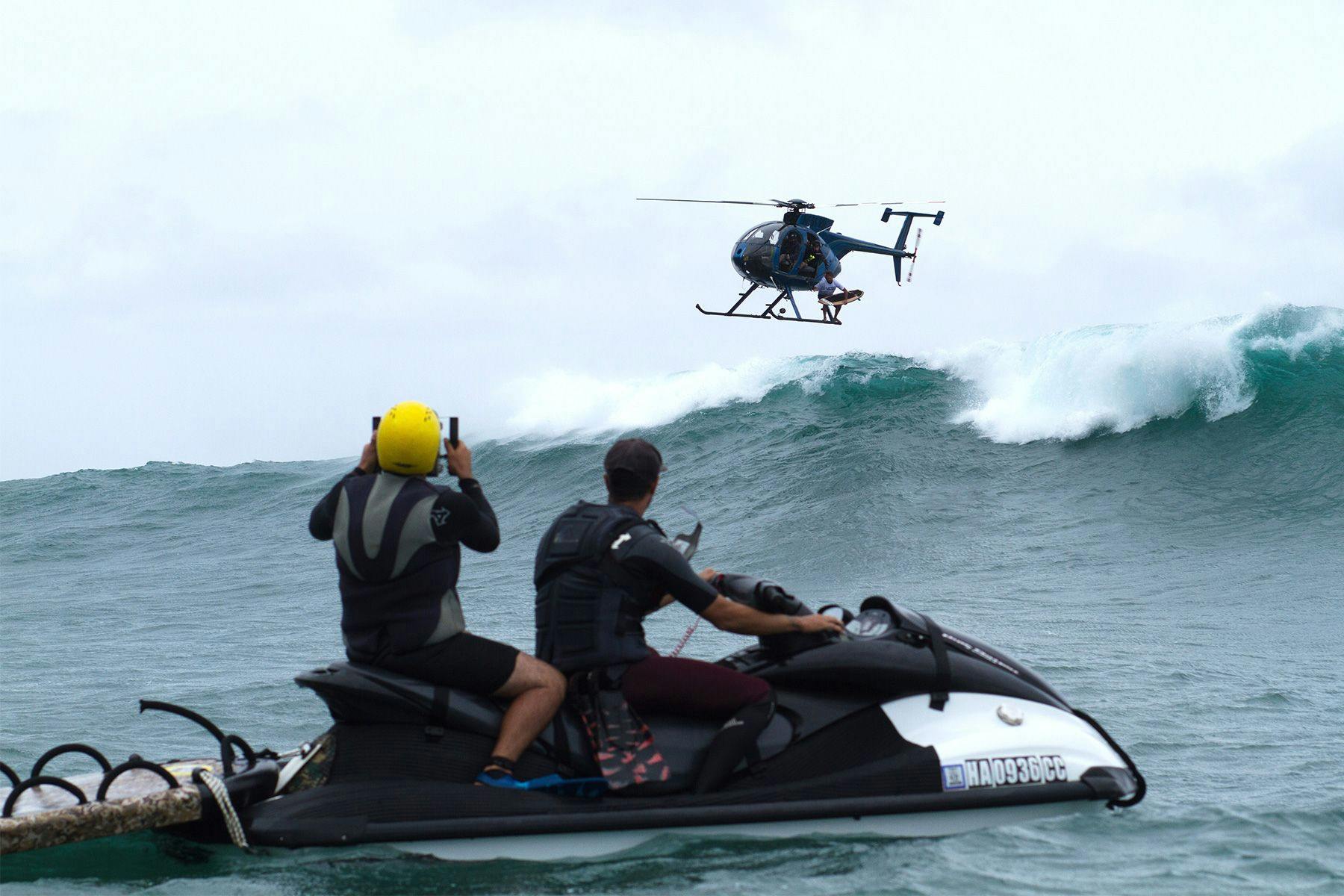
Mike, first up, a documentary about surfing through the eyes and experience of Nathan Fletcher isn’t going to be a normal documentary about surfing. Did you have a story that you wanted to tell, or were you happy to follow the path to wherever it took you?
Mike: Well firstly, I don’t really know what a normal documentary about surfing is, but nothing I want to get involved with should ever be normal and I don’t think Nathan is a big fan of normal either. I think once as you have that premise between the filmmaker and his subject then I think you just let things go where they go, right? But the one thing we did know was that we both wanted to do, as the sort of coup de grace of this whole thing, Nathan jumping out of the helicopter doing the acid drop. I just had to figure out a strategy to get us there, and the history of Nathan and his family is about as a good a narrative strategy as you could have to hang a documentary from.
So starting from that endpoint and worked back from it, how did you meet and get started on this project, and who were the other people that you spoke to as part of it?
Mike: It started in Hawaii. I had met Nathan quite a few years previously through a mutual friend of ours, the artist and filmmaker Julian Schnabel introduced us – you know the guy that did The Diving Bell and The Butterfly, Basquiat and all these great movies. He’s also a surfer from Texas; we met in New York City in the 1970s as part of the new wave independent underground New York scene you know, we were hanging out with Warhol and all those people, and we found out that we were both surfers and believe me, there were no surfers in New York City in the 1970s – it wasn’t like the hipster scene it is now. We got surfing together, and he became a famous painter, like really famous, one of the most famous of all time. I was making movies and you know we always spoke about collaborating on things and one day he was having a big gallery show and he said “I’ve got someone you wanna meet Michael” and he introduced me to Nathan’s dad, Herbie Fletcher. Julian and I are of that generation like ten years younger than Herbie Fletcher, so Herbie was like a hero to us. Herbie and I would hang out in art galleries. And then there was this RVCA event happening on the North Shore and there was all this weird shit going on with like, Terry the Magician and all these people from the underground from Lollapalooza, lying on beds of nails and being walked on. And there was Nathan and Bruce Irons. It was just a couple of months after they came back from Teahupo’o and they’ve both been through all this shit with Andy dying and Sion Miloski dying and all that stuff, and the two of them looked like they were haunted. I mean they looked like they had gone through something really bad.
Nathan: Oh we just did not even want to be there.
Mike: I didn’t speak to them, but then later on I was back in Hawaii filming Sunny Garcia for this other documentary I was working on, and something happened. I don’t know, the Eddie was supposed to run I think but it didn’t run, and we didn’t get to film. Then I ran into Nathan and I think I may have run into Woody, Hank Photos’ friend
Nathan- No, you were driving by with Hiriata Hart and you were screaming out the window at me.
Mike: That’s it… I was with Buttons’ widow, Hiriata Hart, who I’ve known for years. Hiriata said “That’s Nathan!” We were looking for someone to film, the Sunny thing wasn’t happening that day because he was in a bad mood, so there was Nathan. We invited him back to our production house and we filmed the first interview that is still in the movie. He spoke in detail about himself and it was just fantastic, and I knew straight away that I had a movie on my hands.
Nathan: Well then he filmed Bruce, and then it went to skateboarding which is in the movie, so it went back to Jay Adams and Christian Hosoi and my brother [Christian Fletcher], and basically it goes back to those days and that’s what lead up to jumping out of a helicopter.
So you go from the advent of aerial surfing, to almost as far as it could possibly go here and now, running the full gamut of it. Nathan, you mentioned then your past with skateboarding, and having turned away from surfing and finding motor cross and snowboarding for a period, because of the expectations and scrutiny that come with your surname. How big a decision was it to open up to a biographical film that digs in, especially one with Mike, and what made you say yes?
Nathan: You know what, that is a great question because I didn’t really know Michaal as well. Obviously did know of some things that he’d done, but you know there was a lot of scepticism, maybe even resistance. But in the end I felt like you know, nothing really matters except for your relationship with the person. Dealing with Michael, knowing that what he said was true and knowing that what he wanted to do was true, I gave him the freedom to figure out how to do what he wanted with the story and I tried to help him as best as I could. It was actually really hard because there was nowhere I could really help him because of the situation. When he came back with the first cut, you know, I was really impressed and so I am really thankful that I let him do what he did, and that I believed in him. My opinion is like, magic, you can never create magic on purpose, it doesn’t happen. You can try as hard as you want, but you just have to hope that it happens. That’s basically the basis of this film, it’s the code red swell, the Tavarua swell, kind of my childhood and performances when I was young, and that leading up to and explaining why I would jump out of a helicopter into a wave. That’s the whole journey, and the rush.
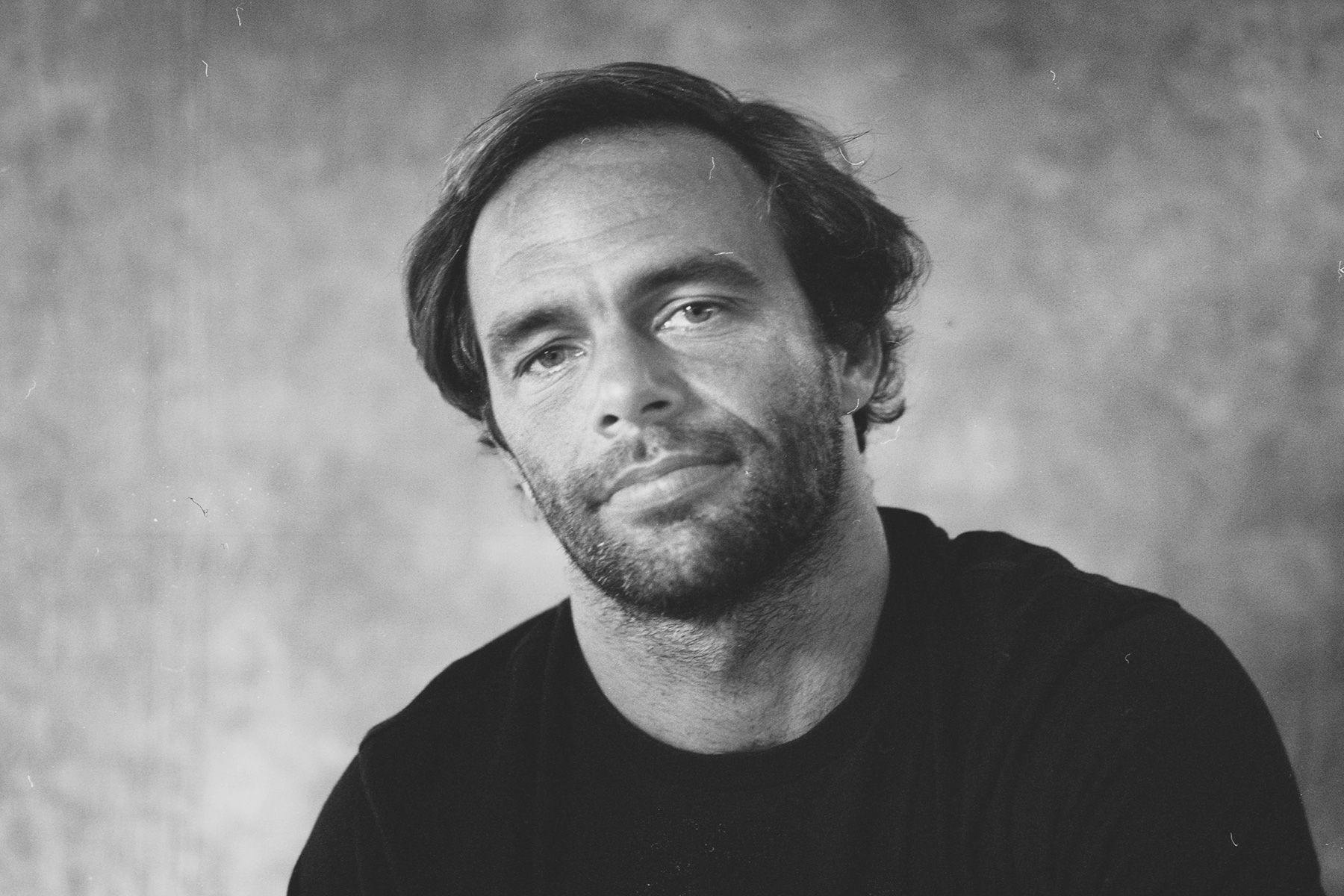
It’s a huge amount of trust to place in that relationship. I mean, you’ve got a bit of a reputation for being reserved and slightly restrained when talking about yourself and what you’ve done, so how did you find that process of opening up to make Heavy Water?
Nathan: I just let it happen naturally, basically. What I am saying is, you know once somebody has given you their word and they do it, it’s easy. When I saw that, it was amazing. I felt like that’s how magic happens.
Mike: The vibe was right, you know.
Nathan: Well yeah you just can’t create it, and so accidentally catching a wave at Tavarua, accidentally catching a wave at Teahupo’o, you can’t prepare for those things, you can’t prepare for these things in your life. It’s more like you’re following your heart, and so once Michael wanted to do this, it was kind of like, I don’t know, I just let him do it. Once he came back with the final cut, I was like “Wow”. Now it’s taken on a whole new life. I don’t even know about movies or movie making, but it’s gone to another level and the great part about it in my opinion, and watching it from a third party perspective, is that it is actually an authentic story told by authentic people, or real people that do it and in a way that surfing has never been shown. When a documentary is memories and people’s recollections, everybody’s recollection is different so the story may be told to the directors liking or whatever. This story being told through facts and events that actually happened, the incidents leading up to them, that were major life stories and had a huge impact in the surf industry and you know, action sports industry. With all those things being recounted by the people involved and with Michael directing the overall narrative and the lighting and sound design and so on, it’s very dramatic. It’s very dramatic at the end and it’s very documentary style at the beginning and leading up to the finale, and so there’re different layers that different people can enjoy.
“You don’t really think about the final finished movie, with the sound on the story, as you’re jumping out of a helicopter, but now the reception is totally different.”
Oh, and the legends too… like Peter Hall you know, and there’s Woody Brown talking, there’s some real surf history in there. All in all, when it came back to have all that being said, it just needed to be out in this world, I’m just gonna say that. And so it has a life of its own as a movie, and I don’t really take it as “oh, that’s me” I just feel like “oh, that’s a story being told” because you know, I don’t want it to be like that. I would rather just be happy that the story’s out there and not even acknowledge the fact that it’s me saying it, you know what I mean? I would get really self-conscious and nervous otherwise and so I blocked everything off. I decided that I was just going to put good energy into it and give it all my blessing and try and let Michael do his best work, and if he does his best work its going to be great, right. And if I don’t do that then, because I’m not on that side you know, I’m not on the technical side – I don’t live in LA, you know? I just had to wish him the best. There’re a lot of things that could be better in my eyes as a surfer looking at it, like the action, because I know the sessions that I had, I know the waves I’ve ridden, I know the things I’ve done, I know the surf, I know all that skating, riding motorcycles, but with his accessibility and the limitations he came up against, it’s actually really great. I guess the last thing I’ll say is the action side of it; for me I just wanna see me in a barrel, or me on the most critical part of the wave or the best rides, as a surfer you know, because that’s what I want my peers to see and that’s what my ego would want, right? It’s not because its like “oh you wanna be the best”, but you just want people to see that, but that’s not an option – you’re dealing with Hollywood and all these other stipulations. When you look at the story, you’re gonna see real footage of me, Sion and Danny Fuller on these sessions and its real time footage of us at the dock, and the real story, so there’s things that maybe I don’t like because it’s not my greatest ride – there were bigger waves but other people already bought the footage. Its just certain things like that, missing paddling in and showing just the bottom of a certain wave, but, there’s other footage of certain things and they are so authentic and real, like, when I’m talking about the day when my child was born, and Kirk Passmore ended up drowning out at Alligators and then that night, my wife went into labour and whatever, and that’s the real story. It’s the real light of that guy going, it doesn’t show him wiping out or anything but if you look out of that side on the stories I’m telling and the footage, it’s really special. And as an action film, you’re dealing with Hollywood and so I am stoked on how that came out. You can’t have your expectations so high, but on the other side of the narrative that’s being told, the stories and the real footage is in there and it makes me pretty much cry every time I watch it.
The helicopter acid drop… there are so many questions! It brought to mind Mike Basich’s famous 2003 snowboard heli-drop, but obviously in this case you are dropping into a moving, dynamic landing. How complicated was it to orchestrate, and what challenges did you have to overcome?
Nathan: That was the interesting part and I’ll just tell you now, from my perspective, like what I imagined when I was a kid, that was me jumping off rocks and doing this same thing as him. I know Mike and Tina and I was friends with them for a long time, everybody has the same thing and so the movie, it goes back to Jay and Hosoi because Hosoi was the first guy to jump off the roof and into the ramp, and Jay Adams was there and Jay being my really good friend. That’s the other narrative in the movie, is that’s how it all started right? With Jay, and then it ended up going to Mikey, and started with Danny Way too, the one thing that wasn’t noted in the movie because of the editing and it got shifted out, for me, jumping out the helicopter was the same in reference to Danny Way. And, when you think of Danny Way, that’s how the mega ramp was invented, right? Because first it was the quarter pipe, then he jumped out of the helicopter with the quarter pipe and then he built a big jump that went into the quarter pipe. So it was like, yeah we should do this – but this is when I was 18, then 26, then 30 and then 36, now we’re talking 40 years old and I still hadn’t done it. But in reference it is all in respect to Danny Way and just trying to advance the sport.
“When it comes down to jumping out of a helicopter, jumping out into a wave, there’s a lot of moving parts that you can’t even calculate.”
I had to try not to think about it, just go and do it and I never thought about the tail rotor, I just thought about the down draft because I was just so concerned about the down draft being so heavy, but the down draft doesn’t matter really because you’re so low. The other thing is, you only have so many tries you can do. It’s not like you can go down and get back up easily. You fall, you get on a jet ski, you go find your board, then you gotta take a ride to the beach, then you gotta get up the beach, take the golf cart, take a ride, wait for the helicopter.” It took like an hour for just one jump. And so yeah, like, six hours into it I was like this has to get done, and it’s not about how big it is, it is about completing it and riding the wave. I could have jumped out a hundred times at a hundred feet high but the whole thing was that you want be standing on your board, that was the thing. And the pilot had to go really low to the wave because if you do a step off from a jet ski then you think about jumping off the jet ski seat, on a moving wave, that’s pretty hard. And then because in the end, my feet are probably 5 feet off the water, but how else can you make it? You have to try it fifty times or multiple days or this and that, so when it came down to the production, the insurance, the cameras, the people, and to get the permits to even hang out of the helicopter with nothing attached to a surf board, after two people had crashed in two helicopter crashes, that was a whole ordeal. The FAA had to come out to the beach, and then the pressure is on to make it. So yeah, you try it 5 times, you start to get pissed, and in the end I’m really thankful that I made, and I am thankful that it got done. I definitely didn’t do it to the potential I thought it had, and what the, maybe somebody can go bigger or whatever. But the fact is, it was completed and done in the wind and all the different elements.
Mike: And then we will do Heavy Water 2 when we will step it up another level…
Nathan: No, step it down a notch!
Mike: The first thing, Phillip Mondel from Red Bull said was “Can we do it at Jaws?”
And you guys said yes right?
Mike: Right!
Nathan: That was the original plan, but in the time it has taken, my life has totally changed, and so its like, if that happens that would be great. That’s actually the whole thing – lets hope somebody does do that with a wing suit hoverboard or something.
That’s a massive amount to orchestrate, and you mentioned things like the down draft and the wind, and the rain,
Nathan: Yeah it’s crazy, but you know what, it has sparked so many ideas for so many crazy things, so that’s a great thing too. Even in my own head, now its got Rush Randall involved, and his knowledge, because Rush helped me on the day with safety; so many people did, but Rush he was the foil guy, you know.
Mike: Rush was definitely very energised afterwards, talking about doing a wing suit jump, into Jaws and all these things. We’ve gotta make this a world wide success, we’ve gotta get this financed and go and do that. We can really rope in some post modernist athletes that will all be inspired by Nathan, you know, and Rush, and make that next step into the future.
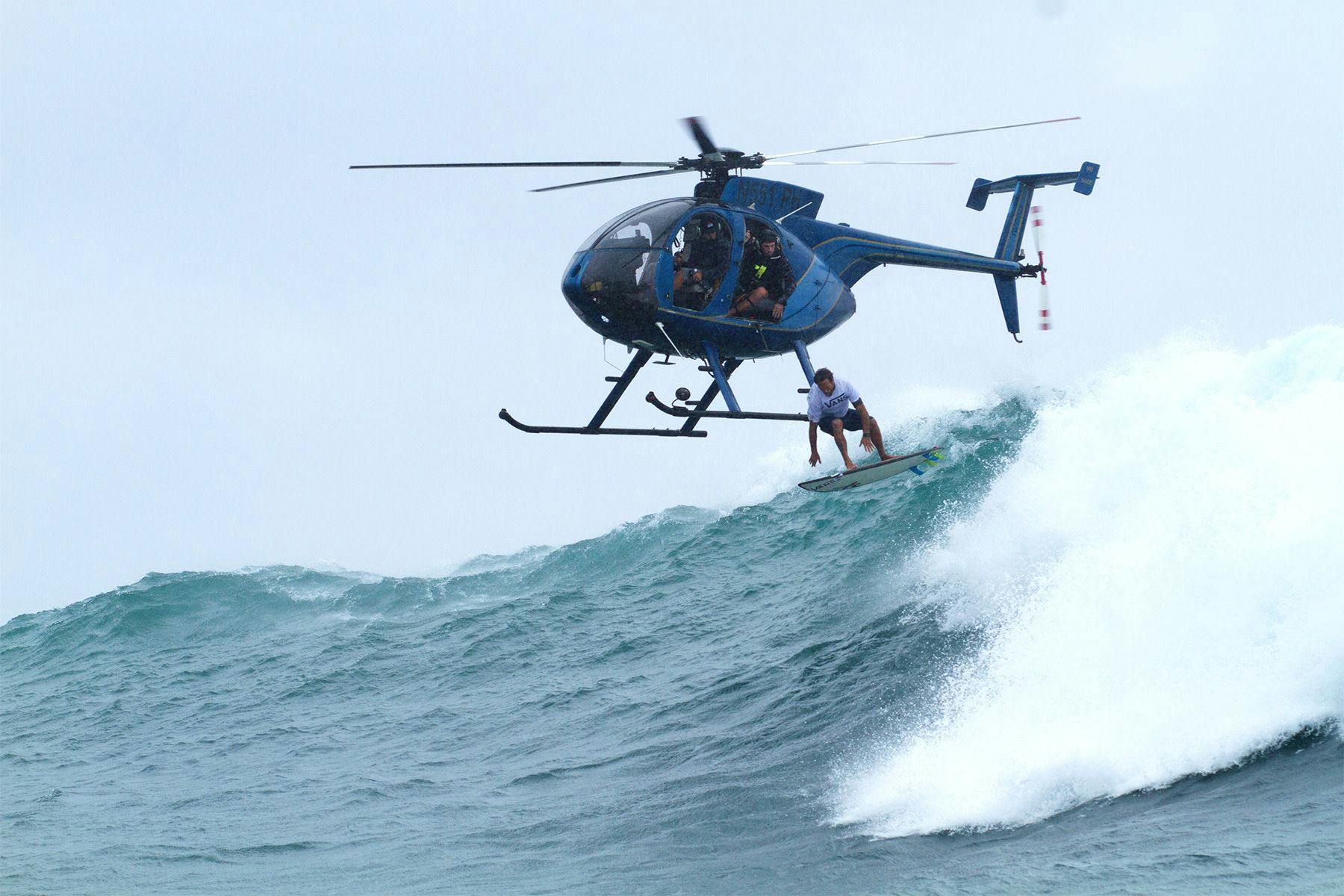
Mike, the helicopter pilot, you basically had to find the Nathan Fletcher of helicopter pilots right?
Mike: Yeah that was a whole other issue.
Nathan: He’s the guy we haven’t even talked about. He’s a great dude and his ability was insane.
Mike: Originally, when we started off with this idea, we thought how could we do this? Do we do it at Jaws, or where and how do we do it? Then we were steered to Don Shearer. You know you always see that yellow helicopter at Jaws? Those are the guys that do it in Maui, but then it became clear that we had to do it on Oahu because it was impossible to do it on Maui. So then we needed an Oahu-based pilot that everybody felt comfortable with. Nobody had the experience of flying a helicopter in giant surf the way Don Shearer has, but he was on another island and that took on a whole other universe of problems with financial issues to bring helicopters across and all that stuff. Then I was introduced to the company called Paradise helicopters who are based at Turtle Bay at the hotel, right on the North Shore. There were two pilots there, one was a guy called Josh Laing and another was called Kahekili Kaaa, and they were both Hawaiian guys. Kahekili is a native indigenous Hawaiian who had also surfed on the pro longboard circuit as a pro surfer, then he joined the Marines and became a helicopter pilot, and was shipped out to Afghanistan. He’d done years of tours of duty in Afghanistan and he’d gone up flying his Black Hawk and he really was into it. It wasn’t like, “Oh shit, I have to go back to Afghanistan and fly the helicopter,” it was like he was out of Apocolypse Now, like one of those kind of guys. The whole thing, the helicopter, the tour of duty in Afghanistan, the longboarding, the surf board, he fit the mold and when I first met him and went for flights with him and Josh, I said to Nathan “you’ve gotta meet these guys, i found the pilots.” But nobody had really heard of these guys, they were flying tourist helicopters around Hawaii. Then we did the test flights with Josh Laing and that was the first time Nathan got to hang out of the helicopter. Then Josh had to go back to Chicago, so he got Kahekili, and we spent a lot of time going through it and talking it through and it was obviously the most exciting thing he had done since flying a helicopter in Afghanistan, and he was unbelievably equipped to do this. I’ve been shooting out of helicopters since I was in my early 20s, which was a hell of a long time ago, back in the days when you were allowed to fly a helicopter through the World Trade Centre spires in New York – I lived in South Africa and when I was 20 I went to live in New York City, I went to Columbia University there and then I became one of the first music video directors in the world, right? So at the time, when there was big budget for music videos, I’d like to hang out the side of helicopters and film with 35mm and insane pilots flying around New York. One video they did loop the loops around the Chrysler building and like, you’re flying above Fifth Avenue, you’re like 300ft above the ground, it was insane right? This guy was this kind of pilot, Kahekili could fly a helicopter like no one I had ever experienced and I have been doing it a long time. It was insane. He could take that thing anywhere – we were like surfing the waves with the helicopter, it was awesome. There’s no way we could have pulled this off without him, he had the helicopter in the waves.
Nathan: It was literally in the waves.
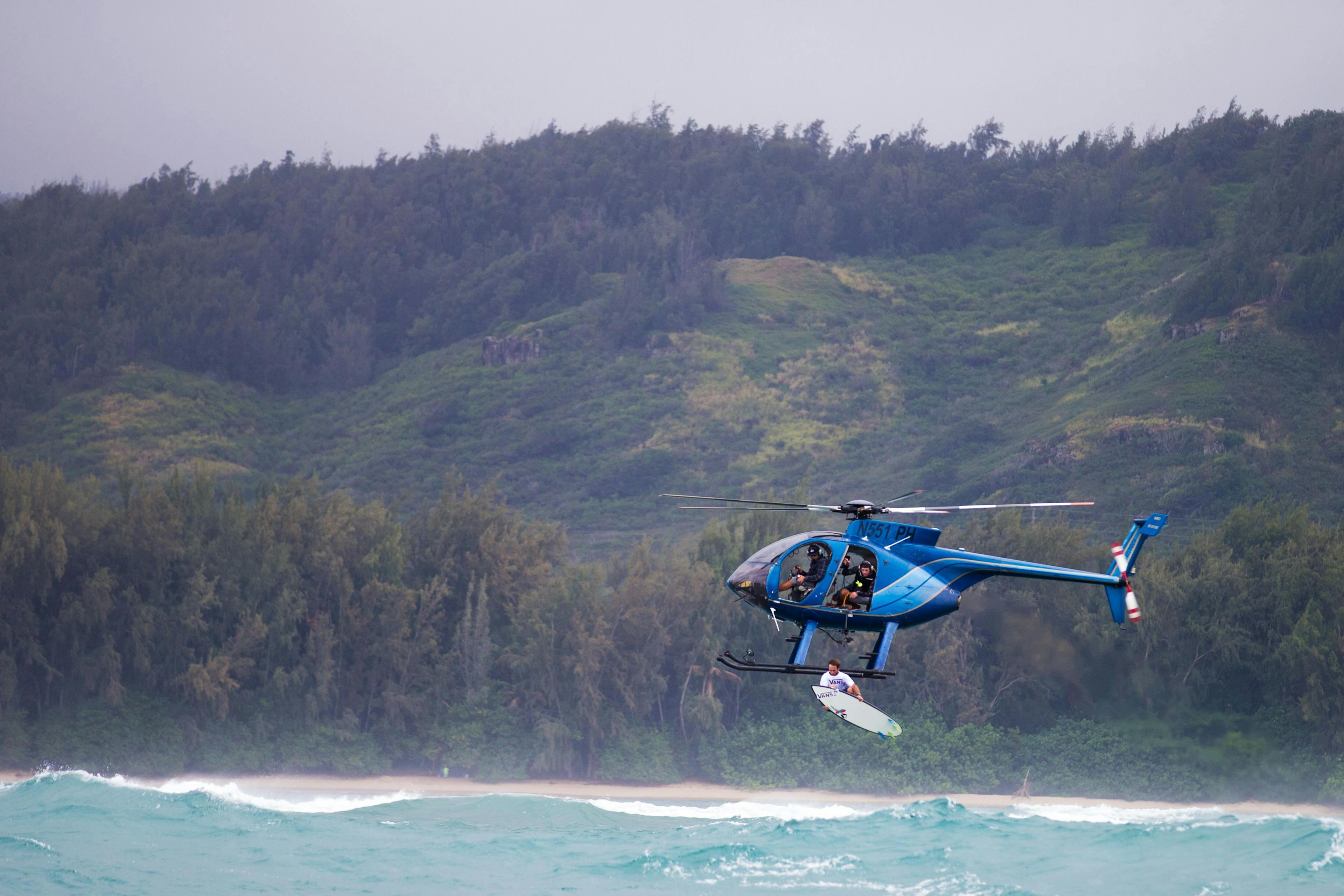
Mike: It was insane, there’s so many great outtakes, just of him flying and doing turns and banking the chopper off the waves.
Nathan: That’s another thing too, that’s one of the parts that’s like, if you’re just a random person who likes suspense and action, it’s pretty insane because his flying is like nothing I’ve ever seen before.
Mike: Yeah, you know, it was such a hassle, we had to get permit for FAA, we had to get the flying permits, on top of that we had to get all the local Hawaiian filmmaking and location and safety permits and water permits, it took me two years basically to get all the permits together, because everytime I got one set of permits, the other set fell through. The truth was, nobody had ever done this before and everybody was shitting their pants that we would kill someone, which was not an unrealistic concern, because it could have happened. We were sitting underneath the helicopter, me and the other camera men with REDS and underwater housings and cameras and phantom cameras all on different jet skis, and as Nathan said in the movie, if he gets cheese grated by the rota of the helicopter, everybody’s gonna go down. Because that chopper was landing on our heads, so it was gnarly.
Nathan: I wasn’t thinking of the pilot
Mike: Yeah, you weren’t thinking of us sitting underneath! But we were…
Nathan: Yeah, it was like a one in a million chance, 1 in 500 maybe…
Mike: We went through a process of elimination. There’s no leg rope on the board right, because, we figured, if the down draft or the wind blew the board up, into the rotors and Nathan was attached to the board it would be a much bigger problem then if the board just blew by itself. The first time when he wipes out and skids on the helicopter and almost kills himself, you know you see him go flying, and he disappears because he’s under a 20 foot wall of water, and then the board, pops up way down, you see Nathan, what I did was I had 85 Go Pro cameras mounted all over the chopper, on jet-skis, one on Rush Randall’s head, I used virtual reality cameras and then stitched them together. I took a VR camera and turned it into a 2D strip; we got these wide panoramic shots so you could really see what was going on, so there was a number of technological innovations which nobody has ever done before – I’ve never seen a movie where you get these wide panoramic shots, these 6 Go Pro cameras stitched into a big wide shot, it looks awesome!
“There’s a lot of real cool shit going on there, but mostly what is going on is this unbelievable pilot flying that helicopter. I mean, I can’t give the guy enough props.”
Without a doubt, I would never do another job anywhere in Hawaii that required a helicopter without having this guy fly. He could bring a helicopter into any situation, like he’s done stuff like when tourists are taking selfies and then fall into the middle of a volcano, he would drop the helicopter into the middle of the volcano with a basket and rescue them. This guy has balls of steel.
Nathan: You know what’s another interesting thing about all of this? The helicopter pilot was a good friend of Sion’s way before, because Sion was a longboarder. There are other weird coincidences, too: the day the film premiered in Honolulu was the anniversary of Kirk’s passing, and it was my son’s birthday the next day which is one of the references in the movie. So it was premiered on the anniversary of one of the big events that happened in the movie, and today’s the big press release day, and today’s my birthday. Last year I had a terrible birthday – I crashed my car, lost my kid in a shop for like 20 minutes, it was the worst birthday ever. It’s funny how all these things happen. There’s been these big events featured in the movie and they’ve become a whole circle of events.
The helicopter acid drop combines the two elements of surfing that you’re best known for airs and waves of consequence. Was this project a natural progression for you?
Nathan: 100%! That’s actually what was not said. Michael did the first interview and I told him the story, and he said he wanted to do this movie but then they came back with a first cut and it wasn’t quite right.
Mike: a lot of people didn’t like the first cut of the movie because at the time it was just a rough cut, an assembly of some of the parts that were going to be the movie, but somehow it got shown… it was a rough road, but we got through it and now we’re here.
Nathan: It was a natural progression; it started with the interview and then I was told that we could get the budget to do the rest of the movie and so the helicopter acid drop was pitched to Red Bull to get the budget. The story narrative goes from when I was a kid and what led to me dreaming of jumping out of a helicopter in to a wave, to me and Bruce and having Andy pass, then losing Sion too, and going to Cloudbreak, then catching the code red swell and finally to how catching those waves led up to the helicopter.
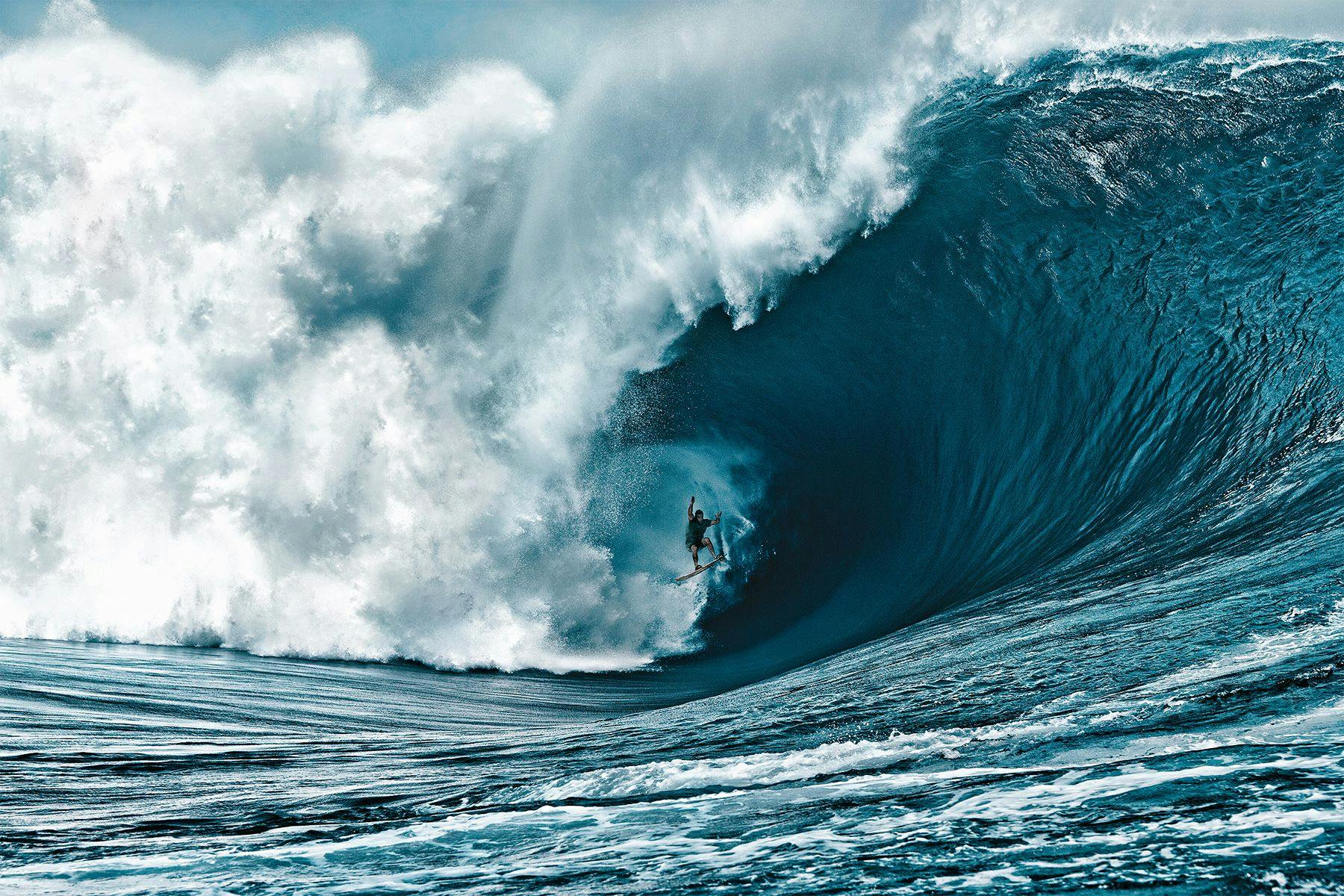
Nathan, its probably an impossible question, but if you had to choose between airs and big or heavy waves, would you be able to?
Nathan: Well yeah, I mean, right now I am at a point in my life where I just enjoy going surfing. I wouldn’t surf the same waves I would have done 10 years ago, or 5 years ago, or even 2 years ago, so I would probably choose airs so that I could surf more!
That’s a good answer, on that point of talking about where your surfing was at and where it is now, have you ever felt the pressure to go beyond your comfort zone because of your natural ability and because of the pedigree your family history?
Nathan: No. You see the thing is, I feel the most comfortable when I’m totally out of control. That was why I would surf in the conditions I would, and the other reason is because I love to surf. I’m grew up in small waves and I would go to these places and surf bigger waves but I love the adrenaline and I love the rush so getting out there is what I do for. I wouldn’t do it because of my family. Well, I guess I would; because they brought me there, they made me, they taught me, and they did it as well, so I guess that is maybe part of the reason. But the main reason is because I just love to put myself in those positions and then deal with it and see what happens, and survive. I wouldn’t do it anymore because although I can probably surf better at this moment, and I train more and take better care of myself, I’m not the same age. I have too much to lose. If I was to keep taking those risks, it would be super unfair; if you take such crazy risks and you survive, at a certain point you ask yourself do you want to keep doing it or do you want to just enjoy your life and be there for your family and yourself and enjoy the ride you’ve had? Because, through all this, a lot of people died and you know they were accomplished people but they left an unaccomplished feeling. They’re not here to enjoy their achievements. After you see your friends die you have a bunch of memories and post traumatic stress and all this shit, at a certain point it’s like you go beyond being excited to surf these waves and you’re super nervous; I would be scared about what the day might bring, not just for myself but for the other people involved. There can be an ultimate consequence, so out of respect for it all I’ve tried to really calculate the risks more. It could happen in a 2ft swell you know, so I try pay more attention and it’s not that I don’t put myself in harms way but I understand that I want to surf until I’m 80, not until I’m 44.
Mike, you’re not one to flinch away from hard truths in your filmmaking. What was the most exciting or eye-opening part of this whole documentary project for you?
Mike: the part that really blew my mind was right in the beginning, after Hiriata and I dragged Nathan off the sidewalk on the North Shore and we started that interview with him up at the house. When he told the story of his last surf with Sion, you could see that he had never really spoke about that event in an unfiltered way, you know, it was few years after the event and he had done a few interviews when it was fresh, right after Sion’s death but this interview was after he had a few years to process it and I almost felt like I was a therapist and he was transferring the story. You could see the degree of trauma that was going through him as he told the story, it was really, really, moving. Then we filmed Grant Washburn, who was there that day at Mavericks when Nathan brought Sion’s body back and who tried to revive him, and Grant is about 6’4”, he’s this huge big guy like an oak tree, and he was telling the story of Nathan and Sion on the beach and he started crying; he said, “I’m not crying for myself, I’m crying for my children.” I realised that this level of extreme sports has a law of diminishing returns. At some point you peak, right? When Nathan described that day at Mavericks with Sion he transported me emotionally into a realm that I had never visited and that was, for me, the most exciting moment of the movie. Everything else is great – the helicopter and when we finally pulled off the acid jump – but the openness, the humanity, and the insight into the mind of these guys was the really exciting thing for me.